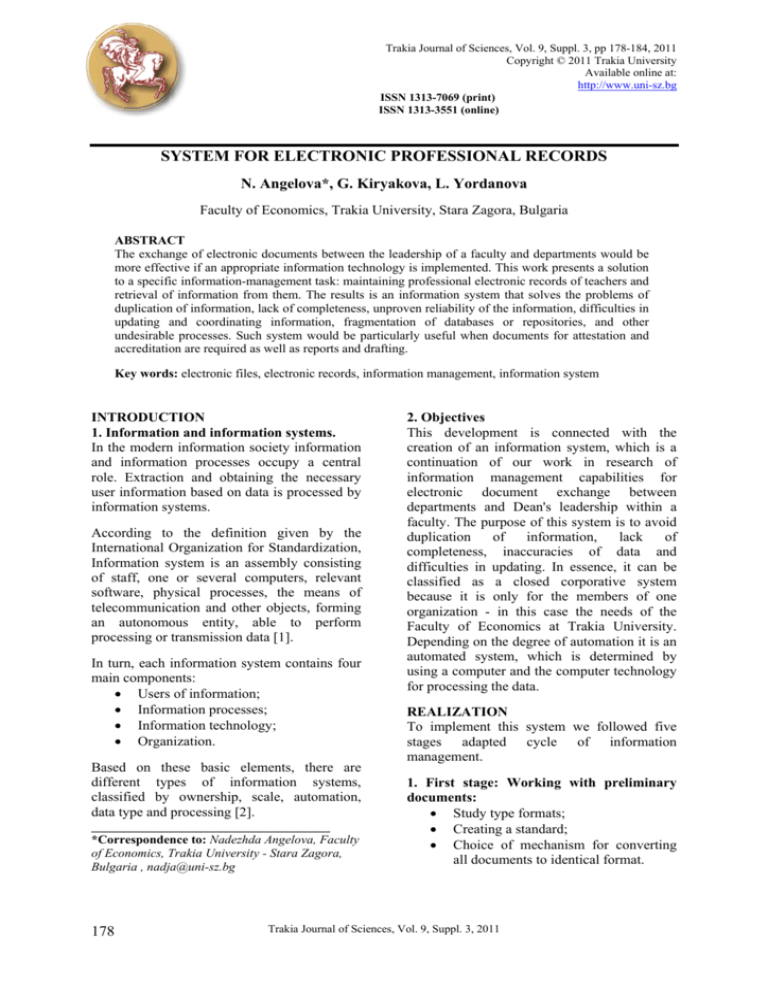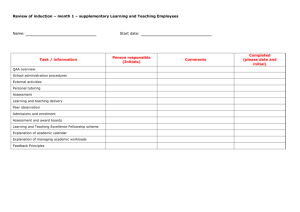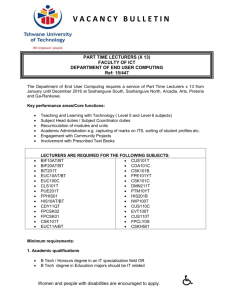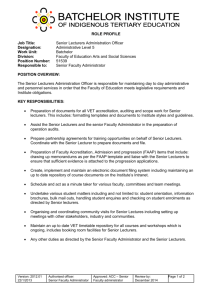as a file
advertisement

Trakia Journal of Sciences, Vol. 9, Suppl. 3, pp 178-184, 2011 Copyright © 2011 Trakia University Available online at: http://www.uni-sz.bg ISSN 1313-7069 (print) ISSN 1313-3551 (online) SYSTEM FOR ELECTRONIC PROFESSIONAL RECORDS N. Angelova*, G. Kiryakova, L. Yordanova Faculty of Economics, Trakia University, Stara Zagora, Bulgaria ABSTRACT The exchange of electronic documents between the leadership of a faculty and departments would be more effective if an appropriate information technology is implemented. This work presents a solution to a specific information-management task: maintaining professional electronic records of teachers and retrieval of information from them. The results is an information system that solves the problems of duplication of information, lack of completeness, unproven reliability of the information, difficulties in updating and coordinating information, fragmentation of databases or repositories, and other undesirable processes. Such system would be particularly useful when documents for attestation and accreditation are required as well as reports and drafting. Key words: electronic files, electronic records, information management, information system INTRODUCTION 1. Information and information systems. In the modern information society information and information processes occupy a central role. Extraction and obtaining the necessary user information based on data is processed by information systems. According to the definition given by the International Organization for Standardization, Information system is an assembly consisting of staff, one or several computers, relevant software, physical processes, the means of telecommunication and other objects, forming an autonomous entity, able to perform processing or transmission data [1]. In turn, each information system contains four main components: • Users of information; • Information processes; • Information technology; • Organization. Based on these basic elements, there are different types of information systems, classified by ownership, scale, automation, data type and processing [2]. _____________________________________ *Correspondence to: Nadezhda Angelova, Faculty of Economics, Trakia University - Stara Zagora, Bulgaria , nadja@uni-sz.bg 178 2. Objectives This development is connected with the creation of an information system, which is a continuation of our work in research of information management capabilities for electronic document exchange between departments and Dean's leadership within a faculty. The purpose of this system is to avoid duplication of information, lack of completeness, inaccuracies of data and difficulties in updating. In essence, it can be classified as a closed corporative system because it is only for the members of one organization - in this case the needs of the Faculty of Economics at Trakia University. Depending on the degree of automation it is an automated system, which is determined by using a computer and the computer technology for processing the data. REALIZATION To implement this system we followed five stages adapted cycle of information management. 1. First stage: Working with preliminary documents: • Study type formats; • Creating a standard; • Choice of mechanism for converting all documents to identical format. Trakia Journal of Sciences, Vol. 9, Suppl. 3, 2011 Studies of electronic documents that are subject of documentation exchange between lecturers, departments, management of faculty and external organizations and evaluation systems was accomplished in cooperation with the Department for Science and International Relations at the Faculty. Such documents are often required for attestation, accreditation statements for certain periods, and other projects. Their preparation, in our observations, is going through very low efficiency. The results of this refers to duplication of information, random and fragmented information, lack of completeness, unproven reliability of information, difficulties in updating and consecution of information fragmentation of databases or used repositories and others undesired processes. One of the important conditions of the effective information management is realizing the specific problem and the need to resolve it [3]. Based on various reports that are constantly required for accreditation, attestations and other activities for the needs of faculty and the university the concept of an uniform standard with regard to personal data of lecturers and scientific output was formed. The decision of transforming main documents from MS Word format to MS Excel format was dictated by the fact that spreadsheets provide better tools for processing and further export to the system. During the conceptual design we specified the main queries. They formed the basis of source documents and the way they will be output to different formats. 2. Second stage: Technology to implement IM: • Survey of IT resources; • Evaluation and comparison; • Selecting a tool This stage is one of the most important for successful implementation of information system. The study of various means of implementing information management proved the claim that it is not a technological problem and concerns mainly human resources [3]. Its successful use depends on the active participation of users. Most systems are Web-based and deal with different data formats. For the needs of the faculty was required single-system to be used within an organization. Our choice was resulted by the fact that its implementation ANGELOVA N., et al. does not need knowledge of programming language and can use other media, which has its own tool environment. According to used software [2], the information system we have created is classified as average level because of the preferred DBMS MS Access. The main reason for choosing it is that the departments have legal copies of this system. Moreover, not all lecturers from the faculty would like details of their products to be available on the Internet and this means that the product of this development should be used now only by Intranet. This, of course, is not a modern understanding of open information society in which we live, but in later stages of work this information system can be submitted online with the input capabilities of MS Access to work in the Web [4]. On the other hand, the project team has experience in other information systems on previous projects with the same DBMS and is familiar with its advantages and disadvantages. 3. Third stage: Database design: • Structure of the tables; • Developing the database; • Applying the rules of reliability of data; • Test; • Documentation; • Training. Within the stage a database is built using relational model. This pattern has the following advantages: • Includes optimal number of tables and attributes that mainly cover the activities of the lecturer; • The structure provides complete initial data; • Use connectivity data to avoid redundant and asynchrony of data; • Facilitates updating data; • The concept of the database is extensible; • Includes criteria for validity of data. Extensibility of the conceptual model must be understood as the ability easily to add new tables, new attributes and characteristics of the lecturer’s work. The criteria for validity of data are compulsory if we want to enter correct primary information and to receive accurate reports. Trakia Journal of Sciences, Vol. 9, Suppl. 3, 2011 179 Database model is now implemented in the DBMS MS Access. It includes the following entities: • Lecturers, • Disciplines, • Projects, • Publications, • Specialisations, • Participation in forums, • Doctoral graduates, • Textbooks. The entity Lecturers is related with a primary table/relation and completing the database should be initiated by it. Permanent lecturer’s data are attributes of that entity: Name, Surname, Code, Scientific degree, Scientific title, Year of acquisition, Additional information (membership organizations), Research directions and Picture. If necessary, these attributes can be changed. For example, code can be excluded if it is not required in the new Law on staff development in higher education. Adding new attributes is also acceptable. The relation Lecturers contains tuples for all teachers of a department. The replication of the database for the management of the faculty will contain tuples for all lecturers of the faculty. Besides those there are auxiliary attributes included to facilitate the reference to publications in Bulgarian and English. Recording the names of first author and other authors is different. Often there are not any applicable standards or there are different ones used for the names of the authors and for the 180 ANGELOVA N., et al. list of publication. Standardization or use of a unique common standard for lists of publications, personal or cited in the article, is a problem of all systems evaluating quality in our country. Disciplines is the entity that connects every teacher with subjects led by him. Attributes Leading lecture and Other lecturers are applicable in cases where more than one lecturer lead a discipline. Other attributes: Speciality, Faculty, Credits, Semester, Grade, Pack and Form, uniquely characterize the discipline, but the code of discipline is crucial to its unique record. This is the primary key field of the relation Disciplines, whose unambiguous is now provided by the curricula of individual subjects in different faculties. The publications of the lecturers are connected with the given in the figure attributes of relation Publications: First author, Other authors, Year, Title, Journal / Proceedings, BG / Abroad, Language, Published in:, Date. They are sufficient in our opinion, to characterize the nature of publication. This relation is related to Lecturers by the field First author and relationship type is "one to many". All publications, regardless of the language issue, are tuples in the relation Publications, which facilitates the queries of applications for given periods. Scientific forums presents the participation of lecturers in research events where they could have a particular contribution. The relations Textbooks, Reviews and Diploma thesis reflect the work of the lecturer for education process and work with students. The selected attributes describe sufficiently full each one of the activities and provide queries of references for a certain period of time. Trakia Journal of Sciences, Vol. 9, Suppl. 3, 2011 ANGELOVA N., et al. Entity Participation in projects presents each project in which a lecturer is involved. They are recorded in relation Projects. The identification of projects is by their project numbers from the respective competitive years. Start and End attributes provide information for periods. Between all the entities in the model are defined different types of relationships. Some of them are complex, composed of more than one field. Initially the system was implemented in the Department of "Informatics and Mathematics" by using a centralized database. All major procedures were tested with data from the department, as well as data for 22 teachers from the faculty. So the planned work was extended, but this was done to prepare for implementation of the system throughout the department after the project. To ensure the next stages of work on information system management and maintenance of electronic records for lecturer of departments and faculty assume that entities represented here, their attributes and relationships are sufficiently comprehensive. Data structure provides the required outputs for quality assessment, accreditation and atestation. However the system is open to add new entities and relationships, if the criteria is changing in the future. 4. Fourth stage: Filling the database: • Applying the mechanisms of implementation the existing documents from the first stage; • Replenishment of new documents; Filling the database is essential for the work on this information system. This was done by importing existing documents for the production of lecturers from different resources and text formats into the designed database. For this purpose was established and implemented procedures for entering text format data into structured data (mentioned above). Initialization of the database was followed by creation of the basic interface tools to work with it, which shaped the final look of information system. Figure 1 shows the main menu view of information system. The users can choose one of three main modules of the system: Data entry, Queries and Reports. Fig. 1. Main menu of the information system Data entry module allows editing of entries and adding new records for lecturers, their publications, participation in scientific events and projects, management of theses, reviews and published textbooks. Each of these submodules works in a convenient graphical form. Publications form is used to enter and edit records of the publications in Bulgarian and foreign journals and forum collections (Fig. 2). Trakia Journal of Sciences, Vol. 9, Suppl. 3, 2011 181 ANGELOVA N., et al. Fig. 2. Form of the sub-module Publications 5. Fifth stage: Reports and Statements: • Custom reports; • Export to other formats. Reports module is designed to display the records necessary to summarize the performance of the members of the faculty research output and classes not included in the curriculum. Queries in the system are defined as fixed (without parameter) and flexible (working with parameter). DBMS itself allows users to create custom queries by using the procedure QBE. According to the information that records display in this system queries can be defined as follows: • Queries with parameters defined by the user according to the capabilities of DBMS • Summary and summary with parameter • Number of lecturers in each department • • Total number of items for the faculty without repetition • Number of publications for each department • Number of publications per lecturer– in Bulgarian, foreign language and both Individual • List of publications of a certain lecturer (with parameter) • List of publications of a certain lecturer (with parameter) for a specified period (with parameter) Inspection of the parameter are feasible for arbitrary input, giving the search criteria and filters. So we can get information about the various entities in the system - departments, lecturers and publications. There are some outputs on Figures 3 and 4. Fig. 3. Number of teachers in departments 182 Trakia Journal of Sciences, Vol. 9, Suppl. 3, 2011 ANGELOVA N., et al. Fig. 4. Number of publications of each teacher in Bulgarian language Reports appear as output from the system: They are generated over the basis of reports and they are ready to be printed or exported into either a Word format, or HTML and XML formats CONCLUSIONS When working with the reports of the lecturers’ production, it was necessary to be applied a specific bibliographic standard for the list of publication. It was found that there was no unified standard in Bulgaria. Different journals have different specific requirements, and the same with the library catalogs. Therefore, lecturers prepare their reports in a different way. Despite the created procedure for entering textual unstructured data, it turned out to be very difficult these data to be entered. The last was true for all 22 professional records of the lecturers at the Faculty of Economics. These difficulties can not be resolved on a local level but rather on a global national level which requires a work on creating a unified national system of quality assessment in the universities. In connection to the work on the information system the following application-oriented results are achieved: • • • • • A model based on DBMS MS Access is created. A solution for transfering data from text files in the database is found. The system which was established for managing data files of professional records of lecturers from the Faculty of Economics contains forms for entering primary information, editing and adding information, requests for the removal of aggregated and individual records, and reports which can be printed. The database is filled with the data from the personal documents – the reports of 22 lecturers at the faculty. Two copies of the system have been prepared - a total and department database, which will be submitted to the leadership of the faculty and the departments It is expected that after the training of representatives of each department, the overall system will operate successfully and efficiently. It will automate the preparation of reports on the activities of the lectures and other supporting documents of the departments and faculties Trakia Journal of Sciences, Vol. 9, Suppl. 3, 2011 183 ANGELOVA N., et al. REFERENCES 1. http://www.tuj.asenevtsi.com/Inf%20siste m/I056.htm , last access 07.07.2011 2. Информационни системи. Структура на Web – базирана информационна система. http://www.techinfowire.com/%D0%B8% D0%BD%D1%84%D0%BE%D1%80%D 0%BC%D0%B0%D1%86%D0%B8%D0 %BE%D0%BD%D0%BD%D0%B8-web%D1%81%D0%B8%D1%81%D1%82%D 184 0%B5%D0%BC%D0%B8 , last access 07.07.2011 3. Йорданова, Л., Г. Кирякова, Н. Ангелова, 2011, Информационен мениджмънт на електронни досиета. Trakia Journal 4. Роман Ст., Access бази данни – проектиране и програмиране, O'REILLY, 2003. Trakia Journal of Sciences, Vol. 9, Suppl. 3, 2011




